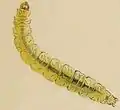Bucculatrix thoracella
Bucculatrix thoracella, the lime bent-wing,[4] is species of moth in the family Bucculatricidae, and was first described in 1794 by Carl Peter Thunberg as Tinea thoracella.[2] It is found throughout Europe with exception of Ireland and the Balkan Peninsula,[4] and in Japan, where it occurs on the islands of Hokkaido and Honshu.[5]
| Bucculatrix thoracella | |
|---|---|
 | |
 | |
| Scientific classification | |
| Domain: | Eukaryota |
| Kingdom: | Animalia |
| Phylum: | Arthropoda |
| Class: | Insecta |
| Order: | Lepidoptera |
| Family: | Bucculatricidae |
| Genus: | Bucculatrix |
| Species: | B. thoracella |
| Binomial name | |
| Bucculatrix thoracella | |
| Synonyms | |
Appearance
Adult specimens of Bucculatrix thoracella are small, with a wingspan of 6–8 mm, and have a wing pattern of dark brown blotches on a yellow base, with a brown line extending to the wing's edge.[6] Larvae have a pale, greenish yellow body and a pale yellow head.[3] Pupae are a dark, cloudy brown,[1] and are covered by a strongly ribbed white, yellowish or greyish brown cocoon.[4]
Behaviour
In continental Europe, Bucculatrix thoracella occurs in two generations per year, whereas it is generally univoltine in most of Britain.[3] It overwinters as a pupa, either on the host plant's trunk or in leaf litter.[7] Adults are on wing in June and sometimes August in Britain,[6] while in continental Europe they are on wing from April to May and from July to August.[8] Eggs are left on the underside of leaves, often at a vein angle.[3]
Larvae
Larvae feed mainly on species of lime tree (Tilia spp.) and less commonly on maple species (Acer spp.),[9] but infrequent records of a variety of other host plants exist.[4] During the first larval stadium, they mine their host plant's leaves,[9] resulting in a small, hook-like mine.[9] The mine starts with a small blotch at the angle of leaf veins, then follows in a straight line along the vein, eventually turning away and forming a hook-like shape.[3] When the larva emerges from its mine, it moults in a smooth cocoonet.[9][4] Afterwards, it feeds externally from the leaf's underside, eating out windows in the leaf.[3][9]
Host plants
Per Plant Parasites of Europe, known host plants include multiple species of maple (Acer campestre, Acer platanoides and Acer pseudoplatanus); Aesculus hippocastanum; Alnus; Betula; Carpinus betulus; Castanea sativa; Fagus sylvatica; Sorbus; and several species of lime tree (Tilia cordata, Tilia × euchlora, Tilia × europaea, Tilia platyphyllos and Tilia tomentosa).[4] Kobayashi, Hirowatari & Kuroko (2010) additionally report Tilia japonica.[5] In parts of its range, it is found solely or nearly so[lower-alpha 1] on Tilia spp.[4] Within Great-Britain, a preference exists for Tilia cordata over Tilia × europaea where both are present.[3]
Gallery
 Mined leaf of lime
Mined leaf of lime Larva
Larva
Footnotes
- solely: Netherlands, Britain; almost solely: Belgium
References
- Patočka, Jan; Turčáni, Marek (2005). Lepidoptera pupae: Central European species. Vol. Text volume. Apollo Books. p. 72. ISBN 87-88757-47-1.
- "Bucculatrix thoracella (Thunberg, 1794) | Fauna Europaea". fauna-eu.org. Retrieved 28 December 2019.
- Heath, John; Emmet, A. Maitland, eds. (1985). Moths and Butterflies of Great Britain and Ireland 2: Cossidae - Heliodinidae. Harley Books. p. 236. ISBN 0946589194.
- Ellis, W.N. "Bucculatrix thoracella". Plant Parasites of Europe. Retrieved 28 December 2019.
- Kobayashi, Shigeki; Hirowatari, Toshiya; Kuroko, Hiroshi (2010). "A revision of the Japanese species of the family Bucculatricidae (Lepidoptera)". Lepidoptera Science. 61 (1): 38. doi:10.18984/lepid.61.1_1. Retrieved 28 December 2019.
- Kimber, Ian. "Bucculatrix thoracella". UKMoths. Retrieved 28 December 2019.
- "14.009 Bucculatrix thoracella (Thunberg, 1794)". British leafminers. Retrieved 28 December 2019.
- "Bucculatrix thoracella (Thunberg, 1794)". Werkgroep Bladmineerders - Bladminerende Lepidoptera van België (in Dutch). Retrieved 28 December 2019.
- Hering, E.M. (2013). Bestimmungstabellen der Blattminen von Europa einschliesslich des Mittelmeerbeckens und der Kanarischen Inseln (in German). Springer-Verlag. p. 20. ISBN 9789401037020.
External links
 Media related to Bucculatrix thoracella at Wikimedia Commons
Media related to Bucculatrix thoracella at Wikimedia Commons